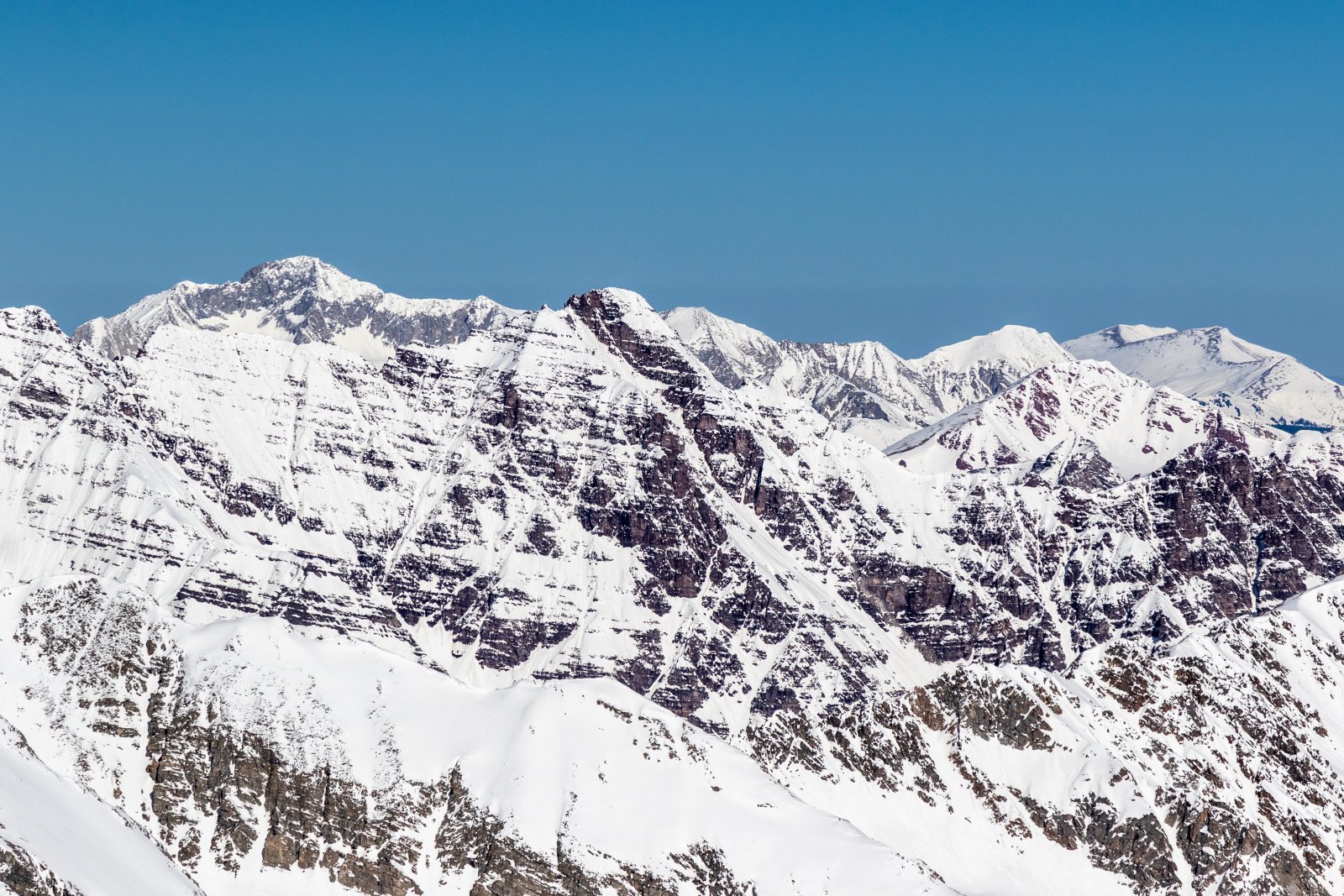
The Landry Line is widely considered to be the shining ski-mountaineering testpiece because it is truly one of the steepest and most exposed lines in the Western US. Seen from the nearby Aspen ski resorts, this was an enticing, terrifying, and visionary line in 1978 when first booted and skied by Chris Landry in full alpine gear! The Landry Line was not repeated until 2006 by Chris Davenport and Neal Beidleman, and still only sees a handful of descents per season. A combination of technical terrain, steep exposed skiing, and a finicky continental snowpack make this a difficult line to get in proper conditions. For that reason, the Landry Line is elusive for many seasoned ski-mountaineers. The Elk Mountains in Colorado are steep and rowdy and this is the king line in the range.
The Landry Line is skied directly from the summit of the imposing Pyramid Peak, one of Colorado’s 58 14,000ft peaks. This line is a good representation of what the Elk Mountains can offer. Long approaches, steep and sustained skiing, and big exposure. Pyramid Peak is made up of crumbling maroon-colored sedimentary rock that both gives it a distinct aesthetic and also an added layer of objective hazard.
The summit is an airy and scary place to hang out and contemplate skiing, but the view will help distract you until it’s time to drop in. The line itself takes a path of least resistance down the east face of Pyramid Peak and between cliffs and rock bands of crumbling rock. Depending on snowpack levels there can be two options to start off the top. It’s possible to work down the rib through some rocks, or enjoy the very steep and exposed hanging face off to skiers right. Both have pitches over 50 degrees in a definite no-fall zone. But the pitch eases off a little and becomes more “fun” as the run transforms into a chute with some edge of the world turns out to the skiers right. Continue fall-line until it cliffs out in a major way. In certain conditions, the choke can be carefully maneuvered without a rope, but it is recommended to go into the line expecting a rappel. It’s only a few hundred feet long and then it’s smooth sailing on the mellow apron for a few thousand feet. Plenty of time to stop and look back up at that crazy thing you just skied down. To continue the exit, just head out East Maroon Creek back to the Maroon Bells road.
While the Landry Line is the prized ski descent in the Elks, you will look around and see a lifetime of quality skiing all around you. Across the glaciated Maroon Creek Valley, you will spot Maroon and North Maroon Peaks, each hosting their own classic steep ski descents. See the East face of Maroon Peak and the North Face of North Maroon peak for a couple more daunting and committing lines.
The Landry Line is most often skied in the springtime from the Maroon Creek Trailhead. Approaching the trailhead will be the first hurdle of your trip. The 6.5 Maroon Creek Road is closed during the winter and spring season during the best windows to ski the Landry Line. As a result, most skiers will take a snowmobile in the early springtime, or bike up the Maroon Creek Road to access the trailhead. From here, skiers will have a couple of options when approaching the summit of Pyramid Peak. Skiers will either follow the summer route along the “amphitheater” route or take the North Facing Banana Couloir route. The north-facing Banana Couloir route tends to hold more snow in the springtime and offers a more direct route to the summit ridgeline. Once you make it to the summit ridgeline, buckle yourself in because it moves slower than it looks. You will pick the path of least resistance through rock bands to the summit. Depending on conditions, you will face various challenges. From booting in faceted unsupportable snow, or manteling rock bands, you will do this above some very significant exposure on all sides.
Getting to the summit of Pyramid Peak is only half of the battle. The first few turns of the Landry Line are the reason why this line is rarely repeated. You will need to feel comfortable skiing 60-degree slopes in less than ideal conditions. The steepness and no-fall exposure are sustained for a couple of thousand feet until your reach the exit of the line. This is the part that you don’t want to get wrong. Here you will encounter a webbing anchor to do a 30-meter rappel to the apron below. If conditions allow, the rappel is not necessary but these are rare conditions. Most skiers will find that they rappel at the choke and finish the line on the long apron.
Due to a tricky continental snowpack, the approach to the Landry Line tends to hold a persistent weak layer throughout most of the skiing season. Waiting until springtime is necessary for an objective like this. Ideal conditions happen as the snowpack goes isothermic and the Elk Mountains get a light springtime dusting that bonds well to the old snow interface. These kinds of conditions only happen a handful of times per season so keeping a careful eye on the peak is paramount to success.
